Telangana SCERT 10th Class Social Study Material Pdf Telangana 7th Lesson Settlements – Migration Textbook Questions and Answers.
TS 10th Class Social 7th Lesson Questions and Answers – Settlements – Migration
Question 1.
What is a settlement?
Answer:
The way we organize ourselves and our living spaces in a place is called a settlement – that is, the geographic space where we live and work. In a settlement, we have different kinds of activities – educational, religious, commercial, etc.
Question 2.
How did human lifestyle change with settlements?
Answer:
Human lifestyles change with a settlement.
Rural Settlement: Much of India’s rural population lives ¡n nucleated villages, which most commonly have a settlement form described as a shapeless agglomerate. Such settlements, through unplanned, are divided by caste into distinct words and grow outward from a recognizable core area. The dominant and higher castes tend to live in the core area, while the lower artisan and service castes, as well as Muslim groups,
generally occupy more peripheral localities. When the centrally located castes increase in population, they either subdivide their existing, often initially large, residential surrounds. add second and even third stories on their Existing houses (a corrosion expedient in Punjab). leapfrog over lower-caste wards to a new area on the village periphery, or in rare cases where land is available, found a completely new village.
Lifestyle in Urban Settlement:
Lifestyle in urban settlements includes big buildings, restaurants, transportation, utilities, and great infrastructure, at the same time it also offers congestion, noise, traffic jams, air pollution, and urban diseases. But It is quite attractive. The cost of living is very high, which forced the cities residents to live in low-quality houses and slums. Everyone runs hard to fulfill their dreams in terms of great life. Likewise, the Tribal lifestyle is also different.
(Or)
Human lifestyles change according to their settlements. It is based on the area they exist.
| Settlement | Human lifestyles |
| 1. Rural area | Simple and normal lifestyles – living together. |
| 2. Town area | Change in dress habits and way of life Is independent. |
| 3. Cities | Costly, luxurious way of life for the rich and slum area life for very poor people. |
| 4. Metro and Mega Cities | Along with luxurious life they face antisocial activities, crime rate Mega Cities problem, lack of amenities, etc. |
Question 3.
How does the Census of India defIne various kinds of places? How does it organize them In order of size and other characteristics?
Answer:
The Census of India organizes settlements in India using certain criteria, The Census department defines various kinds of places i.e. settlements as follows.
| Settlement-type | Criteria used |
| Megacities | Cities having more than 10 million people |
| Metropolitan Cities/Million Plus Cities | Cities having population between one million to 10 million |
| Cities/Class 1 cities | Urban areas having populations between 1 lakh to one million |
| Towns | All the urban areas having populations between 5000 to lakh |
| Revenue/Census village | A village with defined borders |
| Hamlets | A group of houses within the revenue village |
The Census of India organises the above on the basis or in order of size, population, and a few other characteristics.
Examples:
| Mega Cities | Greater Mumbai, Delhi, Kolkata. |
| Metropolitan Cities | Chennai, Hyderabad, Ahmedabad |
| Class 1 Cities | Warangal, Nizamabad |
| Towns | Armur, Bellam Palli |
| Revenue villages | Anantaram, Kanriaigudem |
| Hamlets | Bandigumpu, Chandrampalem |
![]()
Question 4.
What is an aerotropolis? How Is It structured?
Answer:
An aerotropolis s an urban plan in which the layout, infrastructure and economy is centered on an airport, existing as an airport city.
Structure: In an aerotropolis the airport functions as a city in its own right. Many facilities are provided right there.
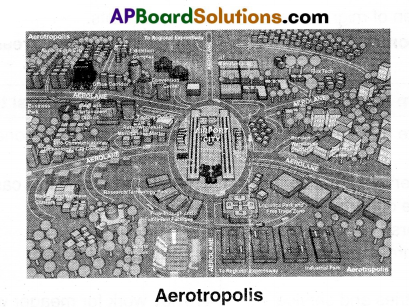
(OR)
- Aerotropolis is the settlement that is centered around large airport.
- In an aerotropolis the port functions as a city in its own night.
- Many facilities like hotels, shopping, entertainment, food business conferencing, etc. are provided night there.
- People can fly in. conduct their business with their counterparts right there and fly out with all the comforts of a city. without traffic and other problems.
- Some form of metropolises are emerging in these places in India; Bengaluru International Airport. Rajiv Gandhi International Airport (Hyderabad). Indira Gandhi International Airport (Delhi).
Question 5.
Read the last para of page 100. “When families migrate ……………….. many of them become dropouts”, and comment on it.
When families migrate. children accompanying their parents do not have creche facilities. Grown-up children are not able to continue their studies at their parents’ new workplaces. Schools in their native place refuse to take them again when they come back. They finally become dropouts, When males leave their families, it is also a major challenge for women who have to take care of all the responsibilities of the family and elderly people who need care. Young girls in such families are required to take care of siblings and many of them become dropouts.
Answer:
Generally landless – agricultural labourers who are living an rural areas are migrating for their livelihood In particular seasons. Because there is no work in their village. Whenever these families are migrating they are taking away their children along with them, to do work in that place and no one Is left in the house to take care about thew children and send to schools. Not only that in Indian villages but there are no creche facilities also The young girls are going along with parents to take care of the siblings.
In migration place, the schools are not allowing to these children in the middle of the year without T.C. but some months Later they come back to their native place, that school also does not allow them because of their absence for a long period of time. Even though Govt. established government B.C., S.C., and S.T. Hostels, these people are not joining their children them m the hostels due to their economic position and they take their children to the work along with them, So, the children of migrant families become dropouts.
Question 6.
Compare and contrast the migration front rural to urban areas and rural to rural areas.
Answer:
| Migration from Rural to urban Area | Migration from Rural to Rural Area |
| 1. People migrate due to insufficient employment. | 1. People migrate seasonally when there is a lot of work. |
| 2. Hope for higher incomes, better services, more opportunities for family members. | 2. Mostly tribal and low caste people migrate. |
| 3. Work as labourers and in un organised sectors. | 3. They are not skilled. |
| 4. Work In industries and service activities. | 4. They work for meager wages. |
| 5. Greater freedom and less discrimination based on caste and gender. | 5. They find employment in sugarcane agricultural activities. |
| 6. They send remittances to their rural families. | 6. No remittances. |
| 7. They mostly live in slum areas. | 7. They live in poor conditions of living. |
| 8. They prefer permanently urban migration. | 8. They go home after their work. |
| 9. Good standard of living. | 9. Poor standard of living. |
Question 7.
Do you think migrants are trouble makers trouble shooters In their destinations? Justify your answer.
Answer:
According to my opinion migrants are not troublemakers or troubleshooters due to the
following reasons.
- Migrants need some work to earn money for their livelihood.
- They adjust quickly to their working or surrounding areas.
- They are not willing to take part in any matters like bandhs, stakes, rallys, etc.
- They seldom lodge any complaint against their employers for the fear of losing their jobs.
- Mostly, as migrants are new to migrated places, areas, they move tenderly and develop relations with their neighbors.
Question 8.
How does rural-to-urban migration increase the purchasing power of people In rural areas?
Answer:
- Urban migrants have plenty of opportunities for education and acquire new skills arid take us new jobs effectively
- Thus they earn more incomes.
- Remittances are an important means of supplementing or generating additional income for the rural families.
- Migration allows households lo meet debt and other obligations without having to sell assets.
- Migrant families buy houses, land, gold, agricultural machinery, and consumer durables.
- Majority of migrants either remit or bring back savings.
- Thus their purchasing power increases.
Question 9.
Why are only professionals able to go to developed countries? Why cannot unskilled workers migrate to these countries?
Answer:
- Generally, the developed countries have limited population.
- Voluntary unemployment prevails in developed countries.
- So, they open doors to the professionals of other countries and offer more and more salaries.
- As they do not find adequate career prospects in their countries, professionals go to developed countries.
- Developed countries depend a lot on industries and service sector.
- They require people with technical skills and professionals.
- So, the unskilled workers cannot serve the purpose.
- Thus, there is no scope for unskilled workers to migrate to developed countries.
- Professionals are able to go to developed countries.
- Unskilled workers cannot migrate to these countries.
Question 10.
Describe the similarities and differences between the Impacts of Internal and international migration.
Answer:
Internal migration: The migration of people from rural to town or another district or other state In a country is called internal migration.
International Migration: The migration of people from one country to another country is called international migration.
![]()
Similarities:
- People move away from their native place of birth.
- The main reason for migration will be better employment opportunities.
Differences
| Internal Migrants | International Migrants |
| 1) They need not avail a passport or visa. | 1) They need to avail a passport, and visa, work permit. |
| 2) They can work anywhere the country. | 2) They should work at prescribed premises. |
| 3) No restrictions to the migrants in leading his lifestyle and he can change his work. | 3) Changing of work In the prescribed period won’t be changed unless and until the authority decides. |
| 4) Leaves will be availed. | 4) Leaves will be decided by the company alone. |
| 5) Freedom of migration. | 5) No freedom of migration. |
Question 11.
Locate the following In the map of India.
i) Chennai
ii) Bengaluru
iii) Delhi
iv) Hyderabad
v) Kolkata
Answer:
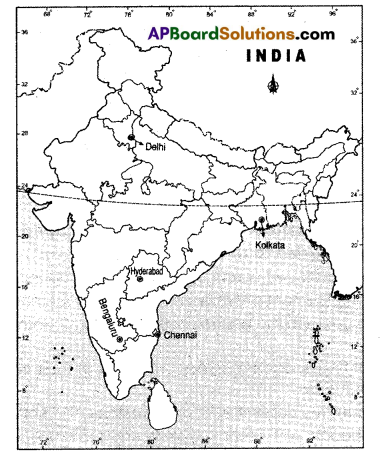
Project
Collect information either from emigrants or Immigrants.

After Collecting the information from the families, analyze the situation and find out solutions.
Answer:

- The emigrants to some nations are suffering and leading their life in sensitive conditions.
- The emigrants should observe the political conditions and moral values of the nations
- they are opting It is better to come back from the nations like Australia.
Debate
Is urbanization a symbol of development or does it lead to problems? Conduct a
debate on it.
Answer:
Student A:
After the industrial revolution, urban population all over the world is increasing. There is a rapid migration of rural people to urban areas for jobs and better living. As a result, the population in the towns and cities is increasing and rural population is dwindling. The rapid in rush of people to the urban areas is pressuring its limited space and causes all types of health and environmental hazards.
Student B:
Advantages of Urbanization:
Growth in ¡ndust rial productions: The production in various industrial sectors like cement, iron and steel, textile, fertilizers, etc. is helping in the economic growth of the country. Exports increase and thus forest reserve increases.
Growth in trade and commerce: Urbanization helps the nation’s business sector. Rural people come to the urban places with their goods.
Development in tourism industries: People from foreign countries are attracted to good cities and towns having better transport facilities. Tourism is a good source of foreign currency for a country.
Improvement in Science. Culture. etc.: Urban places are the meeting point of all good cultures of various localities. Education, science, and technological developments take place in urban places improving the society as a whole.
Student C:
Disadvantages of Urbanization:
The rapid inflows of rural population to urban places give rise to housing problem and thus slums are developed in these places.
The decrease in rural population effects the agricultural production due to shortage of workers in rural areas.
The increase in population in urban places pressurizes water and sanitation facilities. It results in environmental pollution, health hazards, etc.
The unemployment increases in urban areas. Due to this various criminal activities, corruption, etc. increase affecting the law and order system.
![]()
TS 10th Class Social 7th Lesson Settlements – Migration Intext Questions
Page No.89
1. Field Work
Look at your own city, town, or village. Draw a sketch map of a selected area using the methods you had learnt earlier. Your map should show the following:
Roads; Houses; Shops and markets; Streams and drains; some Public places like hospitals, schools, bus stands, railway stations, etc;
1) Are the public places located at points that would be convenient to most people?
2) Do you find any patterns In the location of markets?
3) Are the houses in clusters? Are they linked to the main road?
Talk to people in the selected area and find out the changes in the settlement during the past twenty years and the reasons for this.
What amenities should have been provided for, but have not been done?
Answer:

- Yes, the public places are located at points that would be convenient to most people.
- Yes, markets are located near residential areas.
- The houses are in clusters. They are linked to the main road.
A talk to the people: Several changes are occurred during the past 20 years. Shopping complexes, apartments, duplex houses are constructed. Cement roads are constructed. Their area is developed as a small town with all facilities.
The government should have been provided the following amenities but not provided:
- A park
- A hospital
Question 2.
Compare and contrast: Using the information above, compare and contrast nomadic and sedentary lite styles. How many points could you can identify?
Answer:
| Nomadic lifestyle | Sedentary lifestyle |
| 1) The nomads move around and therefore do not create any artwork of great dimensions, if any. | 1) Sedentary having settled down build houses, temples, places, etc. and have the opportunity to create art of all kinds. |
| 2) It is a very hard life and leaves them little time for leisure. | 2) They have more free time and can dedicate themselves to science and technology. |
| 3) They have a love for words and their language is rich and refined. They are born pots and storytellers though many of them do not have a written language. | 3) They developed a writing system. which I was needed for levying taxes, recording property, trade and administration of the country in general. |
| 4) Nomadic people are purity related to the nature. | 4) People produce food by doing agriculture. |
| 5) They lived in band as hunter-gatherers | 5) They are Irving tar to the nature. |
| 6) They do not practise agriculture. | 6) They live independently in different settlements like village towns, cities, etc. |
Page No. 92
Question 3.
Observe the following table.
| Population of Visakhapatnam | ||
| Year | Population | % Change |
| 1901 | 40892 | |
| 1911 | 43,414 | +6.2% |
| 1921 | 44.711 | +3.0% |
| 1931 | 57,303 | +28.2% |
| 1941 | 70,243 | +22.6% |
| 1951 | 1.08,042 | +53.8% |
| 1961 | 2,11.190 | +95.5% |
| 1971 | 3,63,467 | +72.1% |
| 1981 | 6,03,630 | +66.1% |
| 1991 | 7,52,031 | +24.6% |
| 2001 | 13,45,938 | +78.97% |
| 2011 | 20,35,690 | +512% |
Question 1.
In the population data given in the table, are the percentages reported for every decade? If not, which decades data is not reported here?
Answer:
Yes, the numbers reported for every decade except 1901.
Question 2.
From which decade to which decade has the population increase been the highest (in percentage)?
Answer:
1951-1961.
Question 3.
From which decade to which decade has the population increase been the lowest (in percentage)?
Answer:
1911-1921.
Question 4.
Plot the absolute population of Visakhapatnam on a line graph covering 1901-2011. What observations can you make about the changes In the absolute population size?
Answer:

Observations:
- The population growth was stable till 1951.
- The population growth rate was above 50% after independence.
- The decade of 951 to 1961 experienced the highest growth.
- The absolute population has crossed 10 lakhs between 1991 to 2001.
- 11 took 9 decades to cross 10 lakhs whereas it took only one decade to cross 20 lakhs.
Page No. 92 & 93.
Question 4.
Indian settlements in hierarchy.
Answer:
The Census of India organizes settlements in India using certain acetone. In the table-3 the Census department’s definitions of various settlement types are given. Read them carefully and complete the exercise.
A pyramid is given on Text page 93. The bottom-inmost part of the pyramid shows the lowest level of the settlement hierarchy according to the Indian census. The top-most shows the highest level. Fill in the details that are left blank:
- The name given to the particular level of settlement (Two examples are shown).
- Give one example of a settlement from Telangana. (other than In Mega Cities. Why?)
Indian settlements In hierarchy
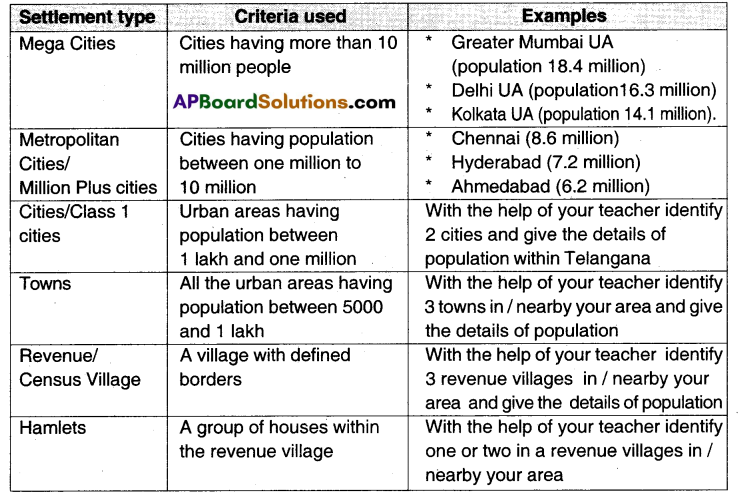
3) Try to pose. the town where you live (If you live in a village, show the nearest town) at the correct level, give I or 2 reasons for your choice.
![]()
4) Do you think settlements should be classified only on the basis of population? Can you think of any other way? Discuss with your teacher and identify the criteria for such classification.
Answer:
1)
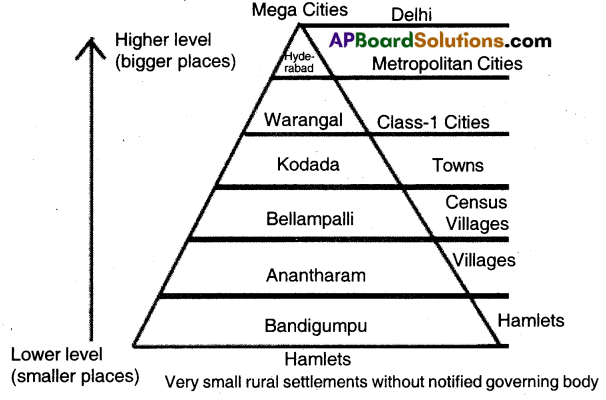
2) Indian settlements in hierarchy

Reason: Telangana has no megacity.
3) I live In Bhadrachalam
Reasons for my choice:
My forefathers opted this town as it is pious. We have business in this town. So I made my choice here.
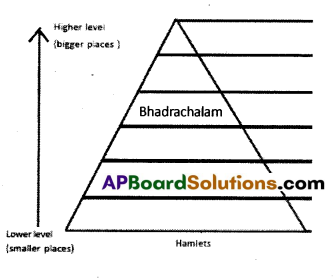
4) Settlement can be classified on the basis of population. It can also be classified on the facilities and historical issues.
Page No. 95
Question 5.
What is at the center of an aerotropolis?
Answer:
The centre of an aerotropolis is a new kind ut settlement with all infrastructural facilities called large airports.
(OR)
- Airport acts as centre of an aerotropoks.
- 2) Aerotropof Is defined as settlements that are centred around large airports.
- 3) This is new pattern of settlements being observed recently in megacities of India like Delhi, Mumbai, Bengaluru, and metropolitan cities like Hyderabad.
- 4) This concept has already been observed in other countries like London, Cairo, Bangkok, UAE, etc.
Question 6.
Name any two facilities located at or near the centre of an aerotropolis.
Answer:
Shopping complexes, hotels.
Question 7.
On an outline map of the world, locate and label the cities given here in the examples. Name the country and the airport also on the map. Remember to use different types of text to Identify the names of the country and the names of the cities and airports, so that it will be easier to see which words are names of countries and which are for cities and their airports.
Answer:
- Kenegouth International Airport (Bengaluru, India)
- Indira Gandhi International Airport (Delhi, India)
- Rajiv Gandhi International Airport (Hyderabad, India)
- Suvarnabhumi International Airport (Bangkok, Thailand)
- Duba’ International Airport (Dubai, UAE)
- Cairo International Airport (Cairo. Egypt)
- London Heathrow Airport (London, England)

![]()
Question 8.
Suppose that the place you have studied about In this chapter gets an aerotropolis near it. Mention 3 ways In which the site features of your place may change. Similarly, mention 3 ways In which the situation features of your place may change.
Answer:
- Suppose that place we have studied about in this chapter gets an aeroiropolis near It.
- The security facilities for the region are beefed up.
- Much of the underground waters are drawn to facilitate those Constructions.
- Many lakes underlying might be covered with soil to facilitate the required land.
- Aerotropolis Is Within 15 minutes walking distance from the Unver5ity gate.
- It is 20 km away from the central bus station.
- It has all-weather connecting roads to all colonies of the city.
Page No. 96
Question 9.
Here is a list of a few people. Categorise them as migrant or non-migrant. Indicate the pattern and guess the probable reasons for migration.

Answer:
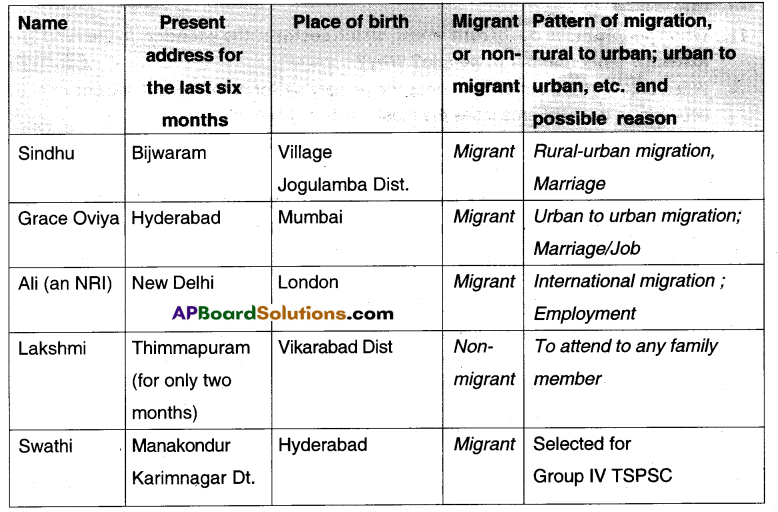
Question 10.
Do you agree with Most of the children are dropouts In migrant families? Explain with examples related to your area.
Answer:
- Yes, I do agree with this statement. When tarnishes migrant, children accompanying their parents do not have creche facilities.
- Grown-up children are not able to continue their studies at new places.
- Schools, in their native place refuse to take them again when they come back.
- Young is in such families are required to take care of siblings. Hence most children of migrant families become drop-outs.
Examples:
A boy named Sohan from my village Anantaram migrated with his family who work as construction labour. Actually, in my village the boy is studying 7th class, They left village without taking T.C. and went to the city. After six months the boy returned to my village. All together six months he did not oin in the school where they had migrated and lost the valuable time.
In the month of July, the boy left the school and returned in the month of December. Here the school authorities rejected him to join in the class and they did not allow him. And they gave suggestions, next year they would allow him in the same class. I felt very bad by seeing the pathetic condition of the boy.
![]()
Page No. 98
Question 11.
When do people move out el rural areas, which sector of the economy In the rural area loses the most number of people? Why?
Answer:
When people move out of rural areas the primary sector or the agricultural sector of the economy In the rural area loses the most number of people.
Reason: Most of the people m rural areas are depending on agriculture. The two other sectors are almost nominal in rural areas.
Question 12.
In urban areas, what are the common sector(s) of the economy In which migrants from the rural areas find employment? What are the reasons for this?
Answer:
- Most urban migrants have to work as labourers and find employment in the unorganised sector.
- They could be working as hawkers, painters, repair persons, and rickshaw pullers. auto drivers, construction labours, etc.
- For some people from rural areas moving to cities and towns to work in industry and other service activities.
Reasons:
- The unorganized sector, the industrial and service sectors need unskilled labour.
- These sector activities have been recognised as a natural response to increase their income and for better family prospects.
Question 13.
Interview a person who has come to a town to work In the unorganized sector as a labourer or domestic servant and write her story
Answer:
Smt. Bura Saroini has come to Hyderabad to work as a housemaid in an officer’s house. She was born in Bhupalpaliy in Bhupalpafly Mandal, Warangal District. She studied there up to 8Th class. Later she got married with Rangaji of Basara, Addabad District. After 25 years of her married lite, he passed away. She got married her two children Then she got an offer to work in Hyderabad. She is happy with her work and earnings. She sent her remittances to her brother to save. She has cleared her loans with her early earnings. She visits her town once in six months.
Question 14.
If you live in a rural area, interview a person who has corn. on a vacation from working in a town In the unorganized sector, write his story.
Answer:
Choragudi Padmanabham, 20-year-old boy, is working as a mason In BhlIai In Madhya Pradesh. He came to our village Polkampally, Addakal Mandai, Mahabubnagar District, Telangana. He came to his Granny’s house to vacation. His father took many loans for his sister’s marriage and his mother’s health Padmanabhan has to repay the loans. So he went to Bhilai for construction works.
The employers offer than Rs. 300/- per day with free accommodation and meals facilities. They took health insurance also to him. So he is enjoying his work and his earnings. He sent his remittances to his lather. But, he feels sorry for missing his family.
![]()
Question 15.
Compare and contrast these two situations.
Answer:
Comparing and contrasting:
Smf. B. Sarojini and Ch. Padmanabham both are working in other places as migrants. Both are working in other places as migrants. Both are working in unorganized sector. Both are working for their livelihood and for repaying their loans.
| Smt. B. Sarojini | Ch. Padmanham |
| 1) She migrated in the same state. | 1) He migrated to other states. |
| 2) She is enjoying limited benefits. | 2) He is enjoying many benefits. |
| 3) She is a widow and alone in her newly life. | 3) He is an unmarried guy. |
Page No.99
Question 16.
Draw arrow lines on the World Map depicting people from India going to different countries mentioned In the above passages.
- USA,
- Canada,
- United Kingdom,
- Australia,
- Germany,
- Norway
- Japan
- Malaysia
- Saudi Arabia
- UAE

Page No. 100
Question 17.
What can be done so that migrants are able to get access to food, health, and family care programmes?
Answer:
- Our central government introduced and passed the food security bill in 2014. If this is implemented properly, they are able to get good food.
- The migrants and their families should get the insurance coverages for their health.
- Their children should be provided with special educational plans to study throughout year continuously without any break.
- The migrants should be provided with clean houses and water facilities at their destinations.
Question 18.
There are some initiatives taken by government and voluntary agencies. Find out if there is any such initiative in your area. Invite some persons from such agencies to talk in the school.
Answer:
1. The government and the voluntary organisation called ‘AMMA’ took up some initiative programmes like
- Mid-day-meals
- Akshara Sankranthi
- Free books to all students
- Dresses to poor people
- Scholarships to the merit students
2. The central government has implemented new schemes like
- Food for all
- 100 days work
- Right to Education
- SSAS – Santa Siksha Abhayan Scheme.
3. The voluntary agencies like Mother Teresa’s organization, etc. help the poor and needy people by providing them food, education, and cloth.
Page No.101
Question 19.
National boundaries are protected against migrants. Here are examples of
a) USA on Mexican border
b) South Korea on North Korean border
C) India on Bangladesh border.
What do you think of migrants across the border?

Answer:
In the above figures the national boundaries of Mexico – the USA. South Korea- North Korea and India – Bangladesh are shown, It Is corridor to arrange a fence between two countries along the border. The soldiers belonging to both the countries always safeguard the borders. But, due to many reasons different people try to cross the borders and enter the neighbouring countries. Sorne among them are terrorists who resort to violence and destruction in their enemy countries. They are induced and inspired by respective countries.
They are called state-sponsored terrorists.
In terms of employment and infrastructure, America is more attractive than Mexico. That is the reason why some people enter that country in illegal ways. Both South Korean and North Korean governments have different doctrines. One is communist whereas the other is capitalist. Those who differ with other countries’ doctrines try to cross the borders and go from one country to other for the sake of spying.
![]()
In Bangladesh. the rule has been dictatorial and the life of people there has been pathetic for ages. So some people of that country cross the border and enter the democratic country India. The states such as Paschim Banga and Assom are facing a grave problem with these people. It’s a crime to cross the borders in an illegal way. And these people become a problem to the country they enter.